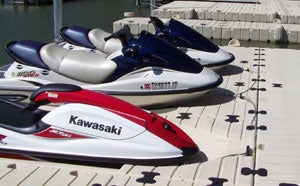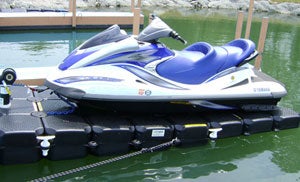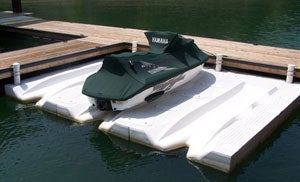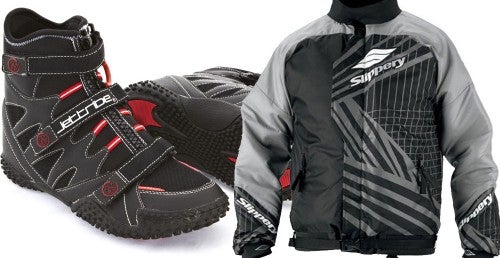Ready-Made Personal Watercraft Docking Systems
Access to your PWC made easy
If you’re lucky enough to keep your PWC at a waterside home (and yes, we should all have that problem), you’re probably familiar with the challenges of storing your PWC. Unlike a traditional boat, manufacturers don’t really recommend you leave your PWC tied to the dock long-term. Hauling them up on the shoreline, however, isn’t always the easiest on the hull…or your back. It can also load the pump with debris or scratch your hull. Getting out the trailer and pulling your PWC out every time you’re done for the day? You might as well not live on the water.
An attractive solution to the problem are the multiple PWC docking systems on the market, ready-made plastic floating docks that can be assembled to an existing dock, seawall, or even beach, and allow you to easily pull your PWC on top to get it out of the water, but still remain convenient and ready to ride.

The most popular docking systems on the market have numerous features in common. The floating platforms are typically molded polyethylene, either filled with foam or featuring airtight chambers for floatation. Topsides are molded to mimic the hull design of individual models and feature a tapered entry, allowing users to simply drive their PWC on with a small dose of throttle. Once in place and balanced atop the dock, friction and weight keep craft secure. Additional tie-downs can be added for extra security. Launching craft is a matter of sliding the boat back into the water. Docking platforms are typically attached to an existing dock, seawall, or even shoreline via various attachment methods.
Decks are typically nonskid, and stay relatively cool underfoot, allowing you to fuel your craft or perform simple maintenance tasks. Additional platforms are also available to allow owners to construct an entire dock area or line up multiple PWC docks. Sections typically link together via simple plastic and stainless steel hardware. Once assembled, the finished structure is very low maintenance, durable, and easy to disassemble at the end of the season if necessary.

While all products have similarities, they also differ in individual execution. EZDock provides handy rollers to make it simplest to load and launch. SportPort offers a shape that closely matches the craft’s hull design. JetDock opts for individual polymer cubes all around, which are combined to create the desired shape. I’ve had the opportunity to use all three over the years, and all work in similar fashion. Nudge the bow into position and then apply a little throttle to push the craft up and onto the platform; hop aboard and rock backward, pulling at the handlebars to get the craft to slide back into the water. In this regard the EZPort’s rollers make for the simplest launch, but in reality all are relatively simple to use. You may worry that a craft may slip away unintentionally, but I’ve seen these systems in use at busy rental locations and marinas, and they generally perform as advertised. Add a tie-down for overnight use for some added peace of mind.

Cost? They’re not cheap, but keep in mind they’ll likely last a long time and do their job. The most basic systems can easily run upwards of $1,500-2,000; plan on spending significantly more if you start to assemble an entire docking area.
For those that have the luxuries of living by the water, however, their simplicity and ease of use will make it that much easier — and more convenient — to use their PWC.
And that, after all, is the idea.
Related Reading
The No-Stress Way to Launch A PWC at the Ramp
Safe Trailering for Personal Watercraft
2010 Sea-Doo ADVANCED TEC iCATCH I Trailer Review
New storage solution for PWC
Get PersonalWatercraft.com in your Inbox!
Like PersonalWatercraft.com on Facebook
Comments
Most Popular

2025 Yamaha JetBlaster PRO 2-Up Review

2024 Kawasaki Jet Ski STX 160X Review

Remembering the Sea-Doo XP

Whatever Happened to the Wetbike?

2025 Yamaha JetBlaster Review













 Your Privacy Choices
Your Privacy Choices